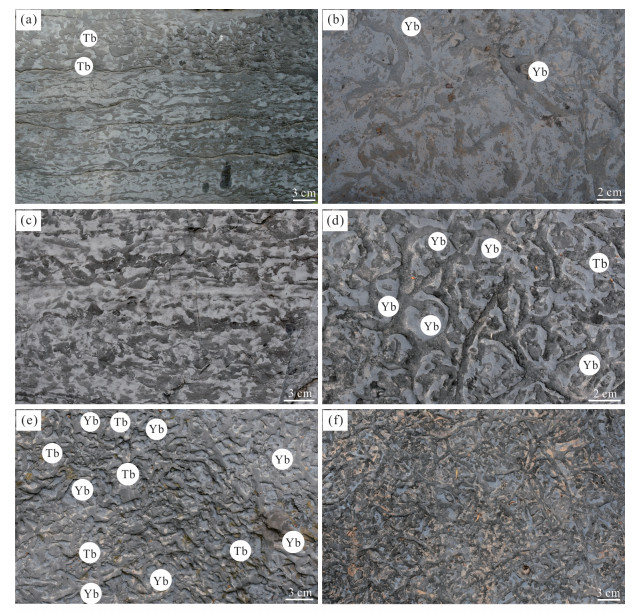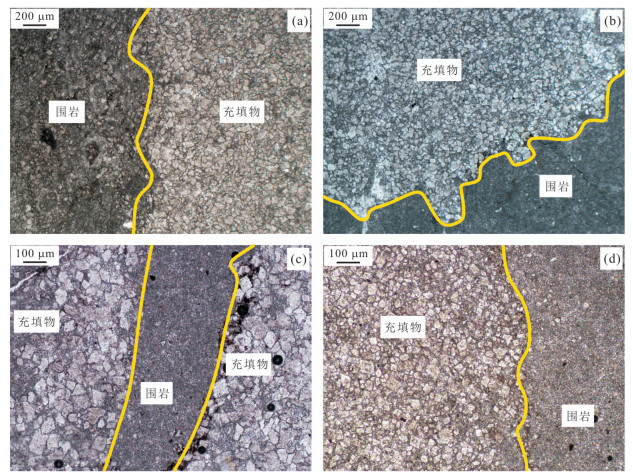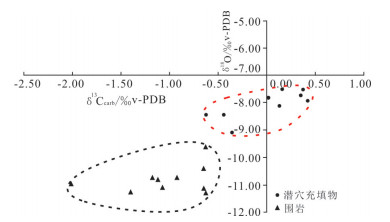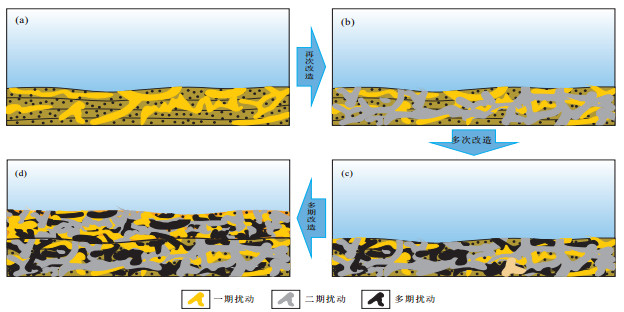Bioturbated Structures and Their Geochemical Features from the Zhushadong Formation of the Cambrian Series 2 in Dengfeng Area of West Henan
-
摘要: 生物扰动在现代海洋沉积物地球化学循环中起着重要作用,它影响着底栖生物群落特性、有机物分解速率、海水化学性质、沉积物氧化还原性以及营养物循环.豫西登封地区寒武系第二统朱砂洞组碳酸盐岩发育了大量以Thalassinoides主导的扰动构造,对其进行碳和氮同位素测定,可以了解扰动生物对沉积物生物地球化学循环影响.测试结果表明,潜穴充填物和围岩中δ13Ccarb值区别显著,不同扰动程度也差异明显,而δ13Corg和δ15N值差异不大,反映出生物对沉积物的扰动改造可以改变沉积物的氧化还原性及孔渗性,这一变化可能与生物扰动引起沉积物孔隙水含氧量增高导致的自生碳酸盐岩比例降低和成岩期白云岩化的增强有关.Thalassinoides造迹生物对沉积物的扰动改造不仅改变了沉积物的原始物理化学信息,促进了海水与沉积物的生物地球化学循环,而且诱导了沉积底质革命,扮演了显生宙早期生态系统工程建造者的角色.Abstract: The bioturbation plays a critical role in modern marine biogeochemical cycling. It influences the character of benthic communities, decomposition rate of organic matter, chemical properties of seawater, redox properties of sediment and nutrient recycling. Abundant bioturbated structures dominated by Thalassinoides occur in carbonate rocks of the Cambrian Series 2 Zhushadong Formation in Dengfeng area of west Henan. The determination of carbon and nitrogen isotopes can help us to understand the influence of bioturbators reworking to sediment biogeochemical cycling. The determination results show that there is a great difference of δ13Ccarb value between the Thalassinoides burrow fillings and matrix, and it also displays a dramatic difference in different bioturbated intensity. But there exists a weak difference of δ13Corg and δ15N values between the Thalassinoides burrow fillings and matrix. The results mean that the sediment reworking of bioturbation can greatly change the redox property, porosity and permeability of sediments. The changes may be related to the decrease of the proportion of authigenic carbonates caused by the increase of oxygen content in sediment pore water and enhancement of dolomitization during diagenesis. The sediment mixing and reworking formed by Thalassinoides bioturbators not only have significantly changed the primary physical and chemical information and promoted the biogeochemical cycle between seawater and sediments, but also may have efficiently triggered the substrate revolution, acting as ecosystem engineers as well.
-
Key words:
- Thalassinoides /
- bioturbated structure /
- biogeochemical cycling /
- carbon isotope /
- Zhushadong Formation /
- sediments
-
表 1 生物扰动指数划分
Table 1. Classification on scheme of bioturbation index
扰动等级 扰动量(%) 描述 0 0 无生物扰动 1 1~5 零星生物扰动,仅有极少清晰遗迹化石 2 6~30 生物扰动程度较低,沉积层理清晰,遗迹化石密度低 3 31~60 生物扰动程度中等,沉积层理界面清晰,遗迹化石轮廓清晰 4 61~90 生物扰动程度较高,沉积层理界面不清晰,遗迹化石密度高,并含有叠覆交叉现象 5 91~99 生物扰动程度强烈,沉积层理完全被破坏,但沉积物的再改造程度并不彻底 6 100 完全生物扰动,沉积物遭受彻底反复扰动 注:据Taylor and Goldring(1993)修改. 表 2 朱砂洞组碳酸盐岩样品无机碳氧同位素测试结果
Table 2. Testing results of δ13Ccarb and δ18O of carbonate rocks from the Zhushadong Formation
序号 样品编号 岩性 测试岩样 δ13Ccarb
(‰)δ18O(‰) 1 ZSD-1 白云岩 白云岩 -2.21 -7.58 2 ZSD-2 白云岩 白云岩 -1.99 -6.65 3 ZSD-3 白云岩 白云岩 -0.31 -6.11 4 ZSD-4 白云岩 白云岩 -1.00 -8.94 5 ZSD-5 白云岩 白云岩 -0.91 -10.19 6 ZSD-9 灰岩 灰岩 -0.85 -9.92 7 ZSD-10 生物扰动灰岩 围岩 -1.07 -10.59 8 ZSD-10 生物扰动灰岩 潜穴充填物 -0.44 -8.35 9 ZSD-10 生物扰动灰岩 围岩 -1.18 -10.84 10 ZSD-11 灰岩 灰岩 -0.84 -10.13 11 ZSD-12 生物扰动灰岩 潜穴充填物 -0.37 -9.06 12 ZSD-12 生物扰动灰岩 围岩 -1.09 -11.10 13 ZSD-13-1 生物扰动灰岩 潜穴充填物 0.41 -7.95 14 ZSD-13-1 生物扰动灰岩 围岩 -0.65 -11.19 15 ZSD-13-2 生物扰动灰岩 潜穴充填物 0.39 -7.55 16 ZSD-13-2 生物扰动灰岩 围岩 -0.66 -10.47 17 ZSD-14-1 生物扰动灰岩 潜穴充填物 0.12 -8.13 18 ZSD-14-1 生物扰动灰岩 围岩 -0.91 -10.82 19 ZSD-14-2 生物扰动灰岩 潜穴充填物 -0.17 -7.53 20 ZSD-14-2 生物扰动灰岩 围岩 -0.61 -11.33 21 ZSD-15 生物扰动灰岩 潜穴充填物 0.02 -7.93 22 ZSD-15 生物扰动灰岩 围岩 -0.64 -9.63 23 ZSD-16 生物扰动灰岩 潜穴充填物 -0.37 -7.81 24 ZSD-16 生物扰动灰岩 围岩 -1.40 -11.36 25 ZSD-17 生物扰动灰岩 潜穴充填物 -0.63 -8.56 26 ZSD-17 生物扰动灰岩 围岩 -2.09 -11.47 27 ZSD-18-1 白云岩 白云岩 -1.02 -8.41 28 ZSD-18-2 白云岩 白云岩 -1.20 -8.73 表 3 朱砂洞组碳酸盐岩样品有机碳和氮同位素测试结果
Table 3. Testing results of δ13Corg and δ15N of carbonate rocks from the Zhushadong Formation
序号 样品编号 岩性 测试岩样 δ13Corg
(‰)δ15N(‰) 1 ZSD-1 白云岩 白云岩 -27.86 -0.94 2 ZSD-2 白云岩 白云岩 -30.05 -1.26 3 ZSD-3 白云岩 白云岩 -29.39 -0.85 4 ZSD-4 白云岩 白云岩 -27.34 -1.01 5 ZSD-5 白云岩 白云岩 -28.81 -1.93 6 ZSD-9 灰岩 灰岩 -27.89 -2.09 7 ZSD-10 生物扰动灰岩 全岩 -27.89 0.35 8 ZSD-11 灰岩 灰岩 -28.16 0.59 9 ZSD-12 生物扰动灰岩 全岩 -27.14 -0.40 10 ZSD-13-1 生物扰动灰岩 全岩 -28.84 -0.30 11 ZSD-13-2 生物扰动灰岩 全岩 -28.62 -0.02 12 ZSD-14-1 生物扰动灰岩 全岩 -28.34 -0.65 13 ZSD-14-2 生物扰动灰岩 全岩 -27.45 -1.16 14 ZSD-15 生物扰动灰岩 全岩 -28.51 -0.79 15 ZSD-16 生物扰动灰岩 全岩 -27.16 -1.59 16 ZSD-17 生物扰动灰岩 全岩 -29.65 -1.31 17 ZSD-18-1 白云岩 白云岩 -29.21 -3.88 18 ZSD-18-2 白云岩 白云岩 -29.18 - -
Aller, R.C., 1994. Bioturbation and Remineralization of Sedimentary Organic Matter:Effects of Redox Oscillation. Chemical Geology, 114(3-4):331-345. https://doi.org/10.1016/0009-2541(94)90062-0 Boyle, R.A., Dahl, T.W., Dale, A.W., et al., 2014. Stabilization of the Coupled Oxygen and Phosphorus Cycles by the Evolution of Bioturbation. Nature Geoscience, 7(9):671-676. https://doi.org/10.1038/ngeo2213 Boyle, R.A., Dahl, T.W., Bjerrum, C.J., et al., 2018. Bioturbation and Directionality in Earth's Carbon Isotope Record across the Neoproterozoic-Cambrian Transition. Geobiology, 16(3):252-278. https://doi.org/10.1111/gbi.12277 Buatois, L.A., Narbonne, G.M., Mángano, M. G., et al., 2014. Relict Ecosystems at the Dawn of the Phanerozoic Revolution. Nature Communications, 5:3544. doi: 10.1038/ncomms4544 Canfield, D.E., Farquhar, J., 2009. Animal Evolution, Bioturbation, and the Sulfate Concentration of the Oceans. Proceedings of the National Academy of Sciences, 106(20):8123-8127. https://doi.org/10.1073/pnas.0902037106 Cao, C.Q., Wang, W., Yan, G.S., 2002. Carbon Isotope Variation near the Boundary of the Permian-Triassic System in the Meishan Area, Zhejiang. Chinese Science Bulletin, 47(4):302-306 (in Chinese). doi: 10.1360/02tb9072 D'Andrea, A. F., DeWitt, T. H., 2009. Geochemical Ecosystem Engineering by the Mud Shrimp Upogebia pugettensis (Crustacea:Thalassinidae) in Yaquina Bay, Oregon:Density-Dependent Effects on Organic Matter Remineralization and Nutrient Cycling. Limnology and Oceanography, 54(6):1911-1932. https://doi.org/10.4319/lo.2009.54.6.1911 Deena, P., George, B., 2011. Bioengineering Effects of Burrowing Thalassinidean Shrimps on Marine Soft-Bottom Ecosystems. Oceanography and Marine Biology:An Annual Review, 49:137-192. http://www.wanfangdata.com.cn/details/detail.do?_type=perio&id=7adf45262ee1ef7f91e52d0fe2c8a293 Dornbos, S. Q., Bottjer, D. J., Chen, J. Y., 2005. Paleoecology of Benthic Metazoans in the Early Cambrian Maotianshan Shale Biota and the Middle Cambrian Burgess Shale Biota:Evidence for the Cambrian Substrate Revolution. Palaeogeography, Palaeoclimatology, Palaeoecology, 220(1-2):47-67. https://doi.org/10.1016/j.palaeo.2003.11.016 Ekdale, A. A., Bromley, R. G., 2003. Paleoethologic Interpretation of Complex Thalassinoides in Shallow-Marine Limestones, Lower Ordovician, Southern Sweden. Palaeogeography, Palaeoclimatology, Palaeoecology, 192(1-4):221-227. https://doi.org/10.1016/s0031-0182(02)00686-7 doi: 10.1016/S0031-0182(02)00686-7 Feng, D., Chen, D.F., Su, Z., et al., 2006. Anaerobic Oxidation of Metane and Seep Carbonate Precipitation Kinetics at Seafloor. Marine Geology & Quaternary Geology, 26(3):125-131(in Chinese with English abstract). doi: 10.1016/S1001-8042(06)60021-3 Gingras, M.K., Baniak, G., Gordon, J., et al., 2012, Porosity and Permeability in Bioturbated Sediments. Developments in Sedimentology, 64:837-868. https://doi.org/10.1016/B978-0-444-5381 3-0.00027-7 doi: 10.1016/B978-0-444-53813-0.00027-7 Horacek, M., Brandner, R., Abart, R., 2007. Carbon Isotope Record of the P/T Boundary and the Lower Triassic in the Southern Alps:Evidence for Rapid Changes in Storage of Organic Carbon. Palaeogeography, Palaeoclimatology, Palaeoecology, 252(1-2):347-354. https://doi.org/10.1016/j.palaeo.2006.11.049 Jin, J.S., Harper, D.A.T., Rasmussen, J.A., et al., 2012.Late Ordovician Massive-Bedded Thalassinoides Ichnofacies along the Palaeoequator of Laurentia. Palaeogeography, Palaeoclimatology, Palaeoecology, 367-368:73-88. https://doi.org/10.1016/j.palaeo.2011.05.023 Jones, C.G., Lawton, J.H., Shachak, M., 1994. Organisms as Ecosystem Engineers. Oikos, 69(3):373. https://doi.org/10.2307/3545850 Kinoshita, K., Wada, M., Kogure, K., et al., 2003. Mud Shrimp Burrows as Dynamic Traps and Processors of Tidal-Flat Materials. Marine Ecology Progress Series, 247:159-164. https://doi.org/10.3354/meps247159 Kinoshita, K., Wada, M., Kogure, K., et al., 2008. Microbial Activity and Accumulation of Organic Matter in the Burrow of the Mud Shrimp, Upogebia Major (Crustacea:Thalassinidea). Marine Biology, 153(3):277-283. https://doi.org/10.1007/s00227-007-0802-1 Koike, I., Mukai, H., 1983. Oxygen and Inorganic Nitrogen Contents and Fluxes in Burrows of the Shrimps Callianassa Japonica and Upogebia Major. Marine Ecology Progress Series, 12:185-190. https://doi.org/10.3354/meps012185 Li, Y.C., 1998.The Carbon Isotope Cyclostratigraphic Responses to Sea Level Change in Upper Permian Limestones from South China.Acta Sedimentologica Sinica, 16(3):52-57(in Chinese with English abstract). http://www.wanfangdata.com.cn/details/detail.do?_type=perio&id=QK199800006551 Luff, R., Wallmann, K., Aloisi, G., 2004. Numerical Modeling of Carbonate Crust Formation at Cold Vent Sites:Significance for Fluid and Methane Budgets and Chemosynthetic Biological Communities. Earth and Planetary Science Letters, 221(1-4):337-353. https://doi.org/10.1016/s0012-821x(04)00107-4 doi: 10.1016/S0012-821X(04)00107-4 Mángano, M. G., Buatois, L. A., 2014. Decoupling of Body-Plan Diversification and Ecological Structuring during the Ediacaran-Cambrian Transition:Evolutionary and Geobiological Feedbacks. Proceedings of the Royal Society B:Biological Sciences, 281(1780):20140038. https://doi.org/10.1098/rspb.2014.0038 Mángano, M.G., Buatois, L.A., 2004. Reconstructing Early Phanerozoic Intertidal Ecosystems:Ichnology of the Cambrian Campanario Formation in Northwest Argentina. Fossils and Strata, 51:17-38. Myrow, P. M., 1995. Thalassinoides and the Enigma of Early Paleozoic Open-Framework Burrow Systems. Palaios, 10(1):58. https://doi.org/10.2307/3515007 Pei, F., Zhang, H.Q., Yan, G.S., et al., 2008. Research on Stratigraphic Paleontology in Henan Province, Volume 3, Early Paleozoic (North China). Yellow River Water Conservancy Press, Zhengzhou(in Chinese). Peng, S.P., He, H., Shao, L.Y., et al., 2002.Carbon Isotopic Compositions of the Cambrian-Ordovician Carbonates in Tarim Basin. Journal of China University of Mining & Technology, 31(4):353-357(in Chinese with English abstract). http://www.wanfangdata.com.cn/details/detail.do?_type=perio&id=zgkydxxb200204006 Qi, Y.A., 1999.The Description and Analysis of Bioturbation and Ichnofabric.Henan Geology, (4): 273-277(in Chinese with English abstract). Qi, Y.A., Meng, Y., Dai, M.Y., et al., 2014.Biogenic Leopard Patch Structures from the Zhushadong Formation (Cambrian Series 2), Dengfeng Area, Western Henan. Geological Science and Technology Information, 33(5):1-8(in Chinese with English abstract). http://www.wanfangdata.com.cn/details/detail.do?_type=perio&id=dzkjqb201405001 Repetto, M., Griffen, B. D., 2012. Physiological Consequences of Parasite Infection in the Burrowing Mud Shrimp, Upogebia Pugettensis, a Widespread Ecosystem Engineer. Marine and Freshwater Research, 63(1):60. https://doi.org/10.1071/mf11158 doi: 10.1071/MF11158 Sang, S.X., Zheng, Y.F., Zhang, H., et al., 2004.Researches on Carbon and Oxygen Stable Isotopes of Lower Paleozoic Carbonates in Xuzhou Area. Acta Petrologica Sinica, 20(3):707-716(in Chinese with English abstract). http://www.wanfangdata.com.cn/details/detail.do?_type=perio&id=ysxb98200403035 Sigman, D.M., Karsh, K.L., Casciotti, K.L., 2009. Nitrogen Isotopes in the Ocean. Encyclopedia of Ocean Sciences, 40-54. http://cn.bing.com/academic/profile?id=22f6390b73e0cf67d51b2d02a58d7457&encoded=0&v=paper_preview&mkt=zh-cn Solan, M., Wigham, B.D., 2005. Biogenic Particle Reworking and Bacterial-Invertebrate Interactions in Marine Sediments. Bioturbation and the Microbial Community, 105-124. https://doi.org/10.1029/60CE07. http://cn.bing.com/academic/profile?id=5a34faaf1f33c0d37be4b486d99ee1ed&encoded=0&v=paper_preview&mkt=zh-cn Stamhuis, E. J., Schreurs, C. E., Videler, J.J., 1997. Burrow Architecture and Turbative Activity of the Thalassinid Shrimp Callianassa Subterranea from the Central North Sea. Marine Ecology Progress Series, 151:155-163. https://doi.org/10.3354/meps151155 Tarhan, L.G., 2018. The Early Paleozoic Development of Bioturbation-Evolutionary and Geobiological Consequences. Earth-Science Reviews, 178:177-207. https://doi.org/10.1016/j.earscirev.2018.01.011 Taylor, A. M., Goldring, R., 1993. Description and Analysis of Bioturbation and Ichnofabric. Journal of the Geological Society London, 150(1):141-148. https://doi.org/10.1144/gsjgs.150.1.0141 Wang, D., Zhu, X. K., Ling, H. F., 2015. Application of Nitrogen Biogeochemical Cycle and Nitrogen Isotope Index in Ancient Marine Environment Research. Acta Geologica Sinica, 89(S1):74-76(in Chinese with English abstract). Wang, D., Ling, H.F., Struck Ulrich, et al., 2016.Organic Carbon Isotope Stratigraphy of the Early Cambrian Huitong Section in Hunan Province, Southeastern Yangtze, China. Geological Journal of China Universities, 22(2):274-288(in Chinese with English abstract). http://www.wanfangdata.com.cn/details/detail.do?_type=perio&id=gxdzxb201602007 Wang, Q.C., Yan, Z., Ning, B., et al., 2016.Characteristics and Genesis of Leopard Limestone of the Ordovician Majiagou Formation in Ordos Basin. Journal of Palaeogeography (Chinese Edition), 18(1):39-48(in Chinese with English abstract). http://d.old.wanfangdata.com.cn/Periodical/gdlxb201601003 Witbaard, R., Duineveld, G.C.A., 1989. Some Aspects of the Biology and Ecology of the Burrowing Shrimp Callianassa Subterranea (Montagu) (Thalassinidea) from the Southern North Sea. Sarsia, 74(3):209-219. https://doi.org/10.1080/00364827.1989.10413430 Zhang, L. J., Qi, Y. A., Buatois, L. A., et al., 2017. The Impact of Deep-Tier Burrow Systems in Sediment Mixing and Ecosystem Engineering in Early Cambrian Carbonate Settings. Scientific Reports, 7(1):1-9. https://doi.org/10.1038/srep45773 doi: 10.1038/s41598-016-0028-x Ziebis, W., Forster, S., Huettel, M., et al., 1996. Complex Burrows of the Mud Shrimp Callianassa Truncata and their Geochemical Impact in the Sea Bed. Nature, 382(6592):619-622. https://doi.org/10.1038/382619a0 曹长群, 王伟, 金玉, 等, 2002.浙江煤山二叠-三叠系界线附近碳同位素变化.科学通报, 47(4):302-306. doi: 10.3321/j.issn:0023-074X.2002.04.014 冯东, 陈多福, 苏正, 等, 2006.海底甲烷缺氧氧化与冷泉碳酸盐岩沉淀动力学研究进展.海洋地质与第四纪地质, 26(3):125-131. http://www.wanfangdata.com.cn/details/detail.do?_type=perio&id=hydzydsjdz200603018 李玉成, 1998.华南晚二叠世碳酸盐岩碳同位素旋回对海平面变化的响应.沉积学报, 16(3):52-57. http://www.wanfangdata.com.cn/details/detail.do?_type=perio&id=QK199800006551 裴放, 张海青, 闫国顺, 等, 2008.河南省地层古生物研究, 第3分册, 早古生代(华北型).郑州:黄河水利出版社. 彭苏萍, 何宏, 邵龙义, 等, 2002.塔里木盆地C-O碳酸盐岩碳同位素组成特征.中国矿业大学学报, 31(4):353-357. doi: 10.3321/j.issn:1000-1964.2002.04.006 齐永安, 1999.生物扰动和遗迹组构的描述与分析.河南地质, (4):273-277. 齐永安, 孟瑶, 代明月, 等, 2014.豫西登封地区寒武系第二统朱砂洞组生物成因的豹斑构造.地质科技情报, 33(5):1-8. http://d.old.wanfangdata.com.cn/Thesis/D739739 桑树勋, 郑永飞, 张华, 等, 2004.徐州地区下古生界碳酸盐岩的碳、氧同位素研究.岩石学报, 20(3):707-716. http://d.old.wanfangdata.com.cn/Periodical/ysxb98200403035 王丹, 凌洪飞, Struck, U., 等, 2016.湖南会同寒武纪早期有机碳同位素地层学研究.高校地质学报, 22(2):274-288. http://www.wanfangdata.com.cn/details/detail.do?_type=perio&id=gxdzxb201602007 王丹, 朱祥坤, 凌洪飞, 等, 2015.氮的生物地球化学循环及氮同位素指标在古海洋环境研究中的应用.地质学报, 89(S1):74-76. http://d.old.wanfangdata.com.cn/Conference/8771783 王起琮, 闫佐, 宁博, 等, 2016.鄂尔多斯盆地奥陶系马家沟组豹皮灰岩特征及其成因.古地理学报, 18(1):39-48. http://www.wanfangdata.com.cn/details/detail.do?_type=perio&id=gdlxb201601003 -









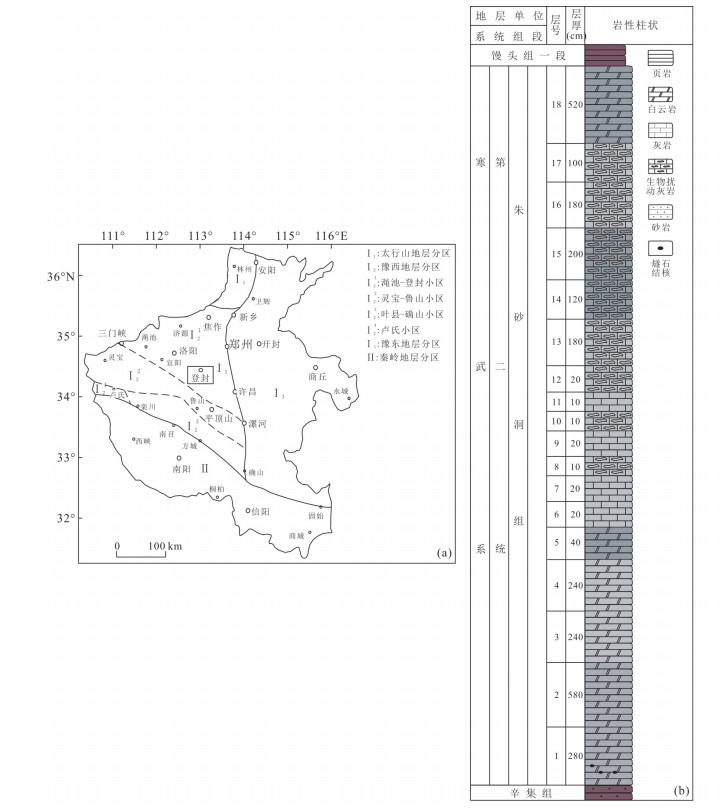
 下载:
下载:

